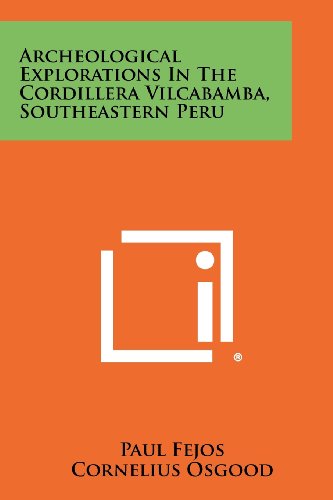Background
He was born in Budapest, Hungary, the son of Desire Emery Fejos, an aristocrat, and of Aurora Novelly. His father died when Fejos was two, and the family lived with his granduncle.



(Viking Fund Publications In Anthropology, No. 3.)
Viking Fund Publications In Anthropology, No. 3.
https://www.amazon.com/Archeological-Explorations-Cordillera-Vilcabamba-Southeastern/dp/1258361191?SubscriptionId=AKIAJRRWTH346WSPOAFQ&tag=prabook-20&linkCode=sp1&camp=2025&creative=165953&creativeASIN=1258361191
anthropologist motion picture director
He was born in Budapest, Hungary, the son of Desire Emery Fejos, an aristocrat, and of Aurora Novelly. His father died when Fejos was two, and the family lived with his granduncle.
In 1921 he received the M. D. from the Royal Hungarian Medical University in Budapest.
Fejos had studied medicine to please his family, but never practiced.
After doing odd jobs he became a research technician at the Rockefeller Institute for Medical Research.
In the course of his work, he became a self-taught anthropologist and ethnographer.
While in medical school he directed films for Mobil Studios. In 1921-1923 he staged plays and operas in Budapest and Paris. In 1923, Fejos moved to New York City.
In 1926, wishing to resume his career in motion pictures, he moved to Hollywood. His first film there, The Last Moment (1928), produced on a budget of $5, 000, won critical praise for its technical virtuosity. He directed several films for Universal Studios, including Lonesome (1928) and The Last Performance (1929), which employed advanced cinematic technique in rapid montage effects and in the use of crowds. For the film Broadway (1929) Fejos and his cameraman invented an overhead steel camera crane that greatly increased the mobility of the sound camera.
In 1930 he directed German and French versions of Big House for Metro-Goldwyn-Mayer. That year he became an American citizen. Fejos returned to Europe in 1931.
He directed films in France (1931), Hungary (1932), Austria (1933), and Denmark (1934 - 1935). In 1936, he made a number of ethnographic films of the people of Madagascar and the Seychelles islands for Nordisk Film of Denmark.
From 1937 to 1939 he directed ethnographic documentary films in Indonesia and eastern Asia for Swedish Film Industry. He wrote and produced A Handful of Rice (1940), a film made in northern Siam about the Maio people. In the course of his work, he became a self-taught anthropologist and ethnographer.
During his Asian expeditions Fejos met Axel Wenner-Gren and began a relationship that was to move his career into new channels.
In December 1939 he led an expedition to Peru under the sponsorship of Wenner-Gren, for the purpose of studying and photographing the Mashco Indians in the upper Amazon Basin. This project was aborted; instead, in 1940-1941, Fejos explored the site of the Inca city of Phuyu Pata Marka and other Inca ruins.
The expedition made topographic surveys and mapped thirty-six square kilometers in the Cordillera Vilcabamba. Five of the largest ruins were cleared of vegetation and mapped. Five smaller sites were studied for land-surface information.
Fejos published his findings in Archaeological Explorations in the Cordillera Vilcabamba, Southeastern Peru (1944).
On the Peruvian expeditions Fejos also studied the Yagua Indians, who were among the least-known of the lowland Peruvian tribes. His report appeared as Ethnography of the Yagua (1943).
His cinematic experience produced a new field technique in ethnography when he filmed the Yaguas reenacting a clan migration to another living site, an event that occurred only once in a generation.
In 1941, Wenner-Gren had established the Viking Fund in New York City to support anthropological research, with Fejos as director of research. The fund became the Wenner-Gren Foundation for Anthropological Research in 1951 under Fejos, who served as president from 1955 to 1963.
He affected the development of anthropology through the research projects supported by the foundation. Fejos was a humanist in his approach to anthropology, and stressed the study of man as the goal of the discipline. The conference "Ceramics and Man" (1961) typified his view, concentrating on the relationship between people and the artifacts they create. Fejos constantly emphasized the need for worldwide communication among scholars, and lent foundation support to international conferences and to the establishment of the journal Current Anthropology. His stress on communication included interdisciplinary exchange between anthropology and other fields, both scientific and humanistic.
In 1947 he brought together researchers in paleoanthropology and geophysics, at a Viking Fund conference in New York City, to discuss and develop the use of carbon 14 for dating fossil remains. He supported an interdisciplinary conference at Princeton in 1952 on the human role in change on the face of the earth.
Through the Wenner-Gren Foundation, Fejos supported a program for the creation of plastic casts of ancient skulls and bones for study. These models were much more accurate than plaster casts, and made rare museum specimens available to schools as teaching tools.
He died in New York City.
(Viking Fund Publications In Anthropology, No. 3.)
Fejos was a humanist in his approach to anthropology, and stressed the study of man as the goal of the discipline.
Fejos' marriages to Mara Jankowsky (1921), Mimosa Pfalz (1925), Inga Arvad (1936), and Marianne Arden (1942) all ended in divorce (1924, 1929, 1942, and 1957). In November 1958 he married Lita Binns. Fejos had no children.
mother Aurora Novelly
2nf wife Mimosa Pfalz 3rd wife Inga Arvad 4th wife Marianne Arden 5th wife Lita Binns
In 1938 while returning from filming in Thailand Fejos met Swedish industrialist Axel Wenner-Gren, who would change Fejos' life in the same way that Edward Spitz had ten years earlier. The two men became fast friends and Wenner-Gren agreed to finance an expedition to Peru in late 1939.
